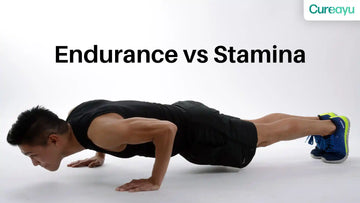In the realm of fitness, there’s a buzzword gaining immense popularity – HIIT. That’s short for High Intensity Interval Training. Celebrities, athletes, and fitness enthusiasts alike are raving about it. But what makes HIIT the cornerstone of contemporary fitness regimes? Let’s dive deep into the wonders of HIIT and find out why it’s stealing the limelight.
Picture this: a workout that’s time-efficient, burns more calories than traditional exercises, and yields quick, robust results. Sounds like a dream, right? Introducing HIIT, a game-changing approach in the fitness world, engineered to push your limits, amplify your metabolic rate, and offer unmatched results. Ready to get started with HIIT? Let's explore this transformative fitness technique in detail.
Also Read: The Ultimate Guide to Exercise During Pregnancy: Safe Workouts and Benefits
What Is HIIT
High Intensity Interval Training (HIIT) is a cardiovascular exercise strategy alternating short periods of intense anaerobic exercise with less intense recovery periods until too exhausted to continue. HIIT’s primary origin traces back to the 1930s with Olympic athletes, but it’s recently made its way into mainstream fitness due to its extraordinary efficiency and effectiveness.
Think of HIIT as an exercise protocol where you go all-out for a short period, followed by a rest or lower-intensity exercise for recovery. These intervals continue in a cyclic manner, engaging your cardiovascular and muscular systems intensively. The beauty of HIIT lies in its versatility. It can be personalized to suit any fitness level, and you can use various exercises like sprints, cycling, or bodyweight workouts.
What Is HIIT Workout
A HIIT workout is crafted with intervals of high-energy bursts followed by brief rest or low-intensity periods. During these high-intensity intervals, you push your body to exert maximum effort, ensuring your heart rate reaches near its maximum. Typical sessions last between 20 to 30 minutes, making HIIT extremely time-efficient.
A classic example of a HIIT workout might involve 30 seconds of sprinting followed by 30 seconds of walking or jogging, repeated for about 20 minutes. Alternatively, it could consist of intense bodyweight exercises like burpees, jumping jacks, or mountain climbers performed in quick succession with short rest intervals. This intense, fast-paced regimen is designed not just to burn calories during the workout but also to boost your metabolic rate long after the session is over – a phenomenon known as the "afterburn" effect.
Also Read: Benefits of Exercise: Understanding the Importance of Physical Fitness for Well-being
Benefits of High Intensity Interval Training
Efficient Calorie Burning
One of the most enticing benefits of HIIT is its ability to burn a significant number of calories in a short period. Due to the intensity of the workout, your body requires more energy to recover, leading to higher calorie burn even after you've finished exercising.
Increased Metabolic Rate
HIIT workouts enhance your metabolic rate, both during and after the workout. This phenomenon, often referred to as excess post-exercise oxygen consumption (EPOC), means your body continues to burn calories after the workout while it recovers and restores itself to a resting state.
Improved Cardiovascular Health
HIIT can dramatically enhance your heart health. The intense intervals push your cardiovascular system to adapt, leading to improved blood circulation, reduced blood pressure, and strengthened heart muscles. Regular HIIT sessions bolster your heart’s efficiency and endurance.
Muscle Gain and Fat Loss
The varied intensity in HIIT workouts helps in both muscle building and fat loss. High-intensity intervals promote muscle growth, while the intense caloric expenditure leads to significant fat burning. This dual action makes HIIT an excellent workout for achieving a lean, toned physique.
Lower Blood Sugar and Insulin Resistance
HIIT has been shown to improve insulin sensitivity and lower blood sugar levels. This makes it particularly beneficial for individuals with type 2 diabetes or those at risk. It enhances your body’s ability to utilize glucose efficiently, thereby managing and preventing high blood sugar levels.
Time Efficient
In today's fast-paced world, finding time for lengthy workouts can be challenging. HIIT provides a solution by offering maximum benefits in minimal time. A typical HIIT session can be completed in 20 to 30 minutes, making it easy to incorporate into a busy schedule.
Also Read: Exercise for Heart Health: Boost Your Cardiovascular Wellness with the Right Workouts
How To Start High Intensity Interval Training
Assess Your Fitness Level
Before diving into HIIT, it’s important to assess your current fitness level. Understanding your physical capabilities helps in customizing the intensity and duration of your intervals, ensuring you don’t overexert yourself. Consider consulting a fitness professional for an initial assessment.
Choose Your Exercises
Select a variety of exercises that you enjoy and that target different muscle groups. This keeps your workout balanced and prevents boredom. Common choices include sprinting, cycling, jump rope, and bodyweight exercises like squats, push-ups, and burpees.
Warm-Up and Cool Down
A proper warm-up is crucial to prepare your muscles and joints for the intense activity ahead. Spend around 5-10 minutes performing dynamic stretches and light cardio exercises. Similarly, cooling down helps reduce muscle stiffness and promotes recovery. Include static stretches and breathing exercises post-workout.
Start With Basic Intervals
If you’re new to HIIT, begin with basic intervals. For instance, 20 seconds of high-intensity exercise followed by 40 seconds of rest. Gradually increase the duration and intensity of your high-energy intervals as your fitness improves.
Listen to Your Body
HIIT is demanding, so it's vital to listen to your body's signals. If you experience pain (not to be confused with the usual discomfort of exercise), slow down or stop. Paying attention to your body's needs helps prevent injury and ensures long-term sustainability of your workout regimen.
Incorporate Rest Days
HIIT puts significant strain on your body, making rest days essential for recovery and preventing burnout or injury. Aim to include at least one or two rest days per week and consider cross-training with low-intensity workouts like yoga or pilates.
Final Words
High Intensity Interval Training (HIIT) is an innovative, efficacious approach to fitness harboring immense benefits. Whether you’re looking to shed pounds, improve cardiovascular health, enhance muscle tone, or simply fit an effective workout into a tight schedule, HIIT has got you covered.
As you embark on your HIIT journey, remember to progress gradually, listen to your body, and prioritize a well-rounded fitness regime. The path to fitness is a marathon, not a sprint. With consistency, persistence, and the power of HIIT, you’re on the fast track to achieving your fitness aspirations. So, lace up those sneakers and prepare to experience the transformative prowess of HIIT!







